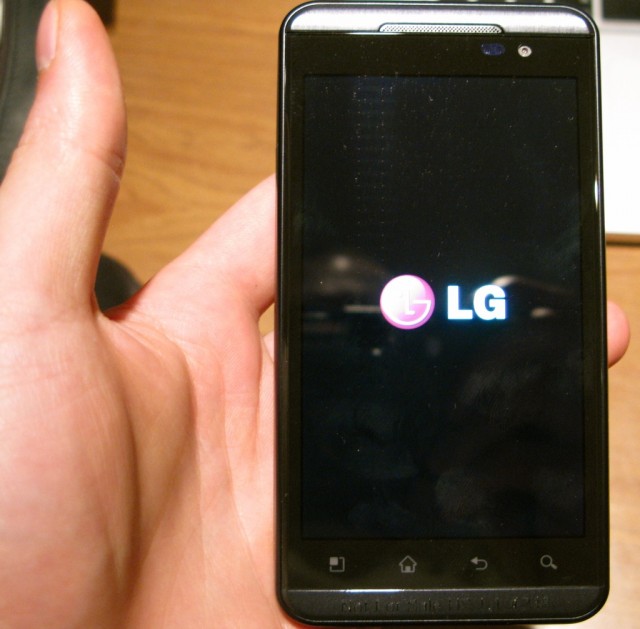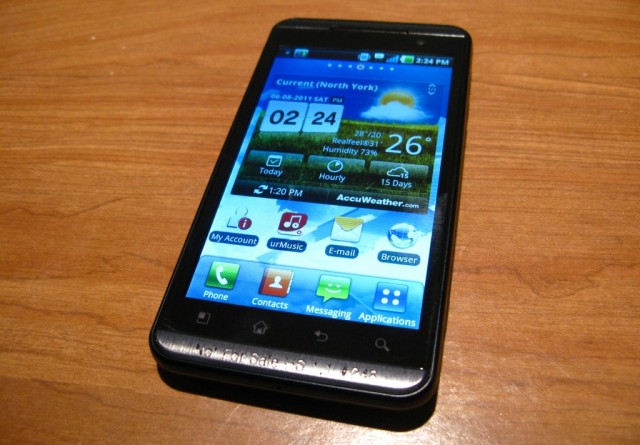
LG has been dipping its toes into the high-end Android market of late, with its Optimus 2X and now Optimus 3D. The realm of 3D phones has yet to be fully tapped, we fear, and the Optimus 3D, despite its stereoscopic proclivities, is a high-end Android phone at heart. This means that while glasses-free 3D is considered a noble attempt to free our eyes from the shackles of “flat” entertainment, there is more than meets the eye (sorry, had to) on this particular device, so let’s dive in and see if LG manages to maintain its vision of an Android future.
Specs:
-Android 2.2 Froyo w/ custom LG overlay -4.3” 480×800 pixel capacitive 3D-capable display
-1Ghz dual-core TI OMAP4430 SoC w/ PowerVR SGX540GPU
-512MB RAM, 8GB internal storage (expandable to 40GB w/ microSD card)
-Dual 5MP back cameras capable of shooting 3MP 3D stills, VGA front camera
-1080p-capable 2D video (24fps), 720p 2D video (30fps), 720p 3D video (30fps)
-1540mAh battery (4hrs talk time)
-WiFi (b/g/n), Bluetooth 3.0 w/ A2DP support, A-GPS, HDMI-out (cable not included)
-128.8 x 68 x 11.9 mm, 168g
-14.4Mbps HSDPA, 5.76Mbps HSUPA -850, 900, 1800, 1900 (2G), 850/1900Mhz (3G)
The Phone:
The Optimus 3D is what polite people would call rotund, though we like to refer to it as having a substantial heart. The 4.3” display appears gargantuan, owed to the fact that LG smartly eliminated much of the vertical bezel from the proceedings, pushing the LCD all the way to the horizontal edge. There is a VGA front facing camera above the 800×480 pixel display, and a jagged-edge speaker grill affixed below a thin piece of glossy plastic appearing to bookend the screen. There are four capacitive touch buttons below the display — menu, home, back, search — the way we like to see them, and unlike the Optimus 2X, no space was wasted in the making of this phone.
Around the left side we have microUSB and miniHDMI ports, covered by a hinge door that we could have done without. Having the HDMI is a bonus, as the O3D is capable of mirroring its screen up to 1080p@60hz. The right side of the device finds the volume rocker near the top, a beautifully delineated piece of plastic that gives back the right amount of feedback; Samsung could learn a thing or two from LG in this regard. Below, near where a dedicated camera button would be, is what we’ve affectionately started referring to as the Portal. In fact, it’s a 3D toggle button that when pressed will take you into LG’s 3D portal which, though it sounds superfluous, is necessary since it’s the only place you’ll experience 3D throughout the UI. More on that later. The top of the device has a 3.5mm headphone jack, and a nice, clicky power button. The back is where it gets interesting, however: two 5MP cameras jut out slightly on a raised plane, marshaled by a metal stripe. The textured backing is fundamentally about adding friction and because it’s a high-quality matte plastic there is no fear of the device dropping which, considering its heft, is an achievement. At 168 grams, the O3D is heavy. It doesn’t feel onerous to hold, however, but the weight will turn off some. A hair under twelve millimetres at its thickest point, the phone is actually quite skinny, but the sheer overall size of it, combined with the density, requires big hands and plenty of pocket space. And a note on the colour: it’s all black, all the time. But for the silver racing stripe, the O3D has one of the most blend-in phone designs we’ve seen: austere, like a blank slate. What’s important is what’s on the screen, and LG is wise to recognize it.

The Display:
At 4.3”, a resolution of 800×480 pixels may seem a bit low, but LG incorporates a high-quality LCD that makes colours pop. Viewing angles are quite good for a non-IPS display, though there is noticeable fading past 30 degrees in any direction. LG has included quite a backlight on this thing, too, as maximum brightness is astounding, allowing the device to be used in direct sunlight when most others can’t. Black and white levels seem fairly clean, though I noticed a slight greyness to blacks when brightness was set to auto.Text appears sharp and there is not a hint of aliasing; the large screen provided a wonderful canvas for reading text, and browsing the web in general was a joy.
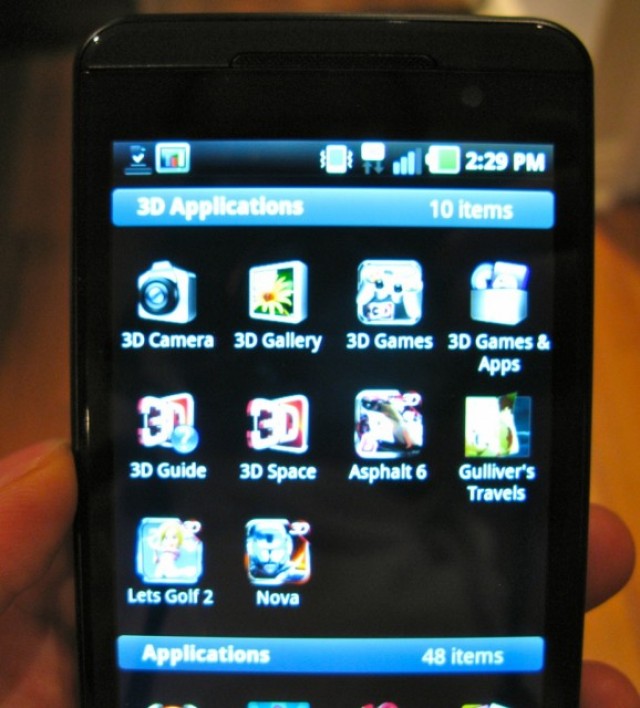
3D or not to 3D:
Here’s the caveat: it’s hard to criticize stereoscopic 3D on a device like this without admitting that we ostensibly get it for “free.” The Optimus 3D is a great Android device without 3D capabilities, so having it there is a true bonus.
That being said, LG goes about it the right way. When we open up the Android app drawer from the home screen, the first category of apps are of the 3D variety: it’s obvious LG is trying to get you to use the feature-set as much as possible. 3D Gallery, 3D Camera, 3D YouTube. 3D games. They’re all there, and when activated the screen goes into “grainy focus” mode, wherein you must adjust the screen to suit your particular eyes. We’ll admit it: when we pressed play on one of the included 3D videos, a trailer for an Imax movie, there were smiles and calls of, “Oh cool!” We passed it to our friends, showed our moms. A couple people even interrupted our dinner to ask to see it. For the most part, 3D works well, combining two distinct images into a single stream that our eyes interpret in three dimensions.
It works fairly well, most of the time, though eye strain is a concern. Content without a lot of fast-moving scenes is better suited to stereoscopic imaging, as muscle fatigue sets in very quickly. LG wisely broke the sample movies into two- to three-minute segments, as the prospect of watching an entire film on the device is not realistic, nor feasible. Watching your home-made 720p 3D movies is probably the coolest aspect of the entire endeavour, and taking 3MP 3D photos makes you want to be a better photographer, aligning forward and backward objects to get the most explicit contrast possible.
Obviously, image quality suffers when viewing 3D content; two images being compressed into one on the same resolution display makes for some grainy stuff. Mostly, however, you’re going to notice how finicky it is to get just the right angle for enjoyable viewing: unlike when wearing glasses, stereoscopic 3D is very sensitive to eye position. Too close and the effect dissipates, too much at an angle and the two images separate. The optimal focal point is around a foot and a half from your head, held straight on. And forget about two people watching at the same time: 3D is a solitary affair in this case. Luckily the screen holds up very well. Colours are bright and animation is fluid; the dual-core processor and speedy graphics processor are as adept as they come. If you want to cast your bet that 3D is the future, or if photography is something you believe needs an extra dimension, you’ll be very happy with the O3D’s capabilities.
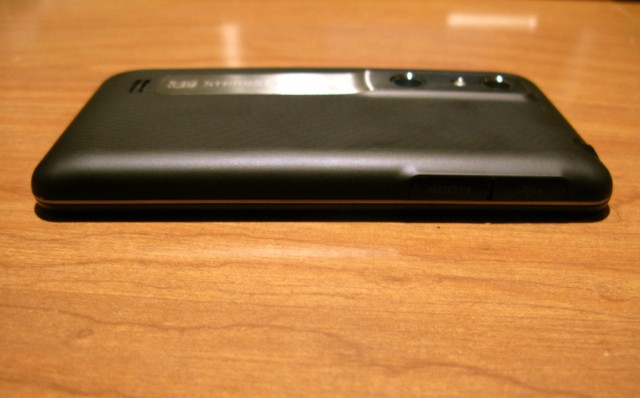
Performance:
It was with stubborn acceptance we discovered the Optimus 3D runs Froyo. Android 2.2.2 to be exact, the same version running on many other newly-released devices like the Optimus 2X and the Motorola Atrix, though both of those devices already have updates in the works.
On the bright side, however, LG has incorporates three “duals” into this device: a dual-core processor (the TI OMAP4430 SoC with a PowerVR SGX540 GPU); 512MB of dual-channel DDR2 memory; and two 5MP cameras. Tri-dual, that’s their marketing pitch. Overall the processor performs on par with the myriad other dual-cores on the market, cozying up closest to the Tegra2 chipset in terms of benchmark results. In fact, the Optimus 3D scores roughly identical results to its Optimus 2X cousin, which runs nVidia’s aforementioned offering. We achieved an average of 2300 on the Quadrant Benchmark Suite, and a 3935ms result on the SunSpider javascript test, significantly faster than the Sensation 4G and Optimus 2X, though some 500ms slower than the Samsung Galaxy S II.
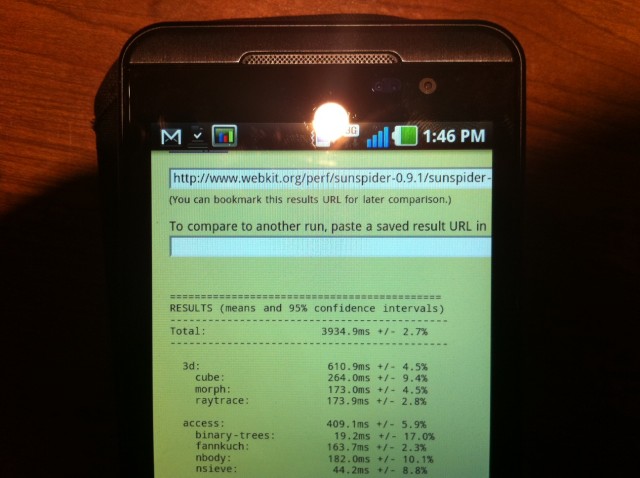
But if you cast your mind back to the Atrix, or even more recently, to the HTC Sensation, you’ll recall our incredulity over how poorly some of these dual-core devices perform in day to day tasks. The Optimus 3D not only has the legroom for some powerful moves, but it excels where it counts: in the feel. Apps open quickly, scroll effortlessly and, most importantly, remain stable. We didn’t encounter a single misbehaving app in our two-week excursion, nor did we experience any slow-down from app “build-up,” a famous Android trait that requires the occasional reboot to flush out errant apps stored in RAM. And though the Optimus 3D runs Froyo, you’d be hard-pressed to tell the difference between it and Gingerbread: LG has darkened the interface to match, offered their own excellent keyboard, and have even updated the Linux kernel to the one found in Android 2.3 (2.35.7). What’s missing from Froyo are a number of low-level APIs, along with support for video calling in Google Talk, a SIP VoIP stack and some performance enhancements. We’re not going to say we’re OK with the device shipping on year-and-a-half old software, but if it had to we’re satisfied with how it turned out.

Cameras:
Plural. There are three cameras on the Optimus 3D, though the back cameras operate as a pair. Individually, they are 5MP, but when taking 2D photos only the outer lens snaps, and it shoots 1080p 2D video. Together, they combine to create 3MP 3D still shots, or 720p 3D video.
Quality on the whole is good, with excellent auto-focus and low-light performance, and a quick shutter to boot. While it won’t give the Galaxy S II or iPhone 4 a run for its money in terms of clarity and detail, we don’t have many criticisms for overall 2D performance. The camera seems correctly calibrated, and noise is minimal especially in well-lit areas. There is too much software compression, which causes muddiness and ghosting, but we were generally happy with the results of our shots. Video performance at 1080p is quite good, too, humming along at a decent 24 fps. 3D photography is a bit of a gamble: you must consider what you’re shooting, and in what context you want it viewed. Because LG is all about synergy, they’d love you to use an HDMI cable to connect the O3D to a 3D-capable television. You can control the depth of focus, or where you want the focus to be (along the border or in the centre) as well as white balance, but for the most part it’s a set-it-and-forget-it procedure.
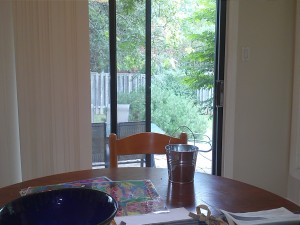

We noticed when filming 720p 3D video that moving objects such as a person walking would come in and out of focus as they moved, resulting in a rather nauseating viewing experience, but in adequate lighting and a slow-moving field of view the effect is quite pleasing. Still photography also takes some getting used to, but when done right there is definitely a wow factor. Just make sure there is sufficient lighting as you cannot use the flash when recording or snapping in 3D. Unfortunately the technology is fairly new, and if 3D is a successful selling attribute in devices like this the next generation should dramatically improve clarity and frame rates. And we’d love it if LG updated the device to allow for the 3D button to also function as a camera shutter as a toggle in the options menu.
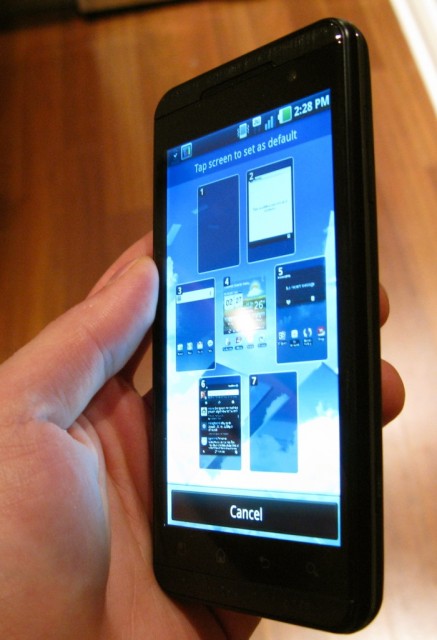
Android a la LG:
We often have a good time poking fun at the way manufacturers believe their alterations to Android are for the good of the customer. Most people, when giving the option, will choose stock Android a la the Nexus S every time, though each camp has its supporters. LG, like Samsung, has taken a middle-of-the-road approach with the Optimus 3D, choosing to slap on a colourful and rather useful launcher along with some cool categorizing inside the app drawer. The notification bar, in addition to being blacked out, has quick toggles for WiFi, GPS and Bluetooth, and for some reason there is a permanent music control bar that sits idle even when nothing is playing. This can be disabled in the music app itself, but it shouldn’t be there by default. The LG keyboard is quite interesting: accurate and quick, it incorporates a XT9 prediction style that builds words based on its internal dictionary. We found it to be jarring and not as accurate as the method utilized by HTC on their Sense UI, but for the most part it hit the right notes, so to speak. We’d still recommend, as we always do, downloading a third-party keyboard such as Smart Keyboard Pro, or even the free Gingerbread Keyboard, from the Android Marketplace, but if tweaking is not your thing, the included one will suffice. As mentioned, the app drawer is divided into expandable and editable categories, something we’d like to see more of. There is a dedicated section for your downloaded apps, and out of the box there are over 40 apps in the pre-installed category, though admittedly many of them are native the native Google fare such as Gmail and Calendar.
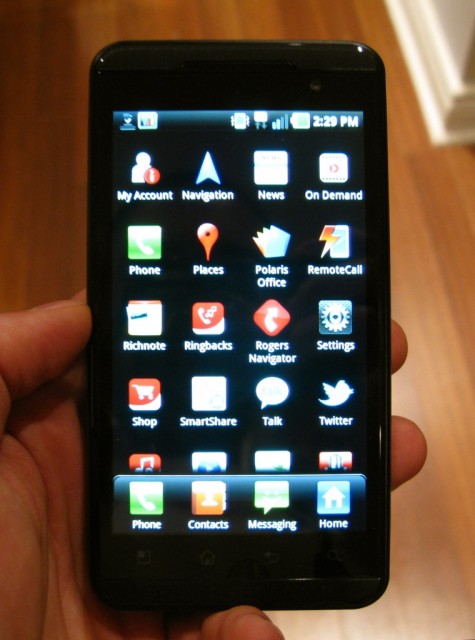
LG peppers the device with their own wares: a DLNA app and a remote assistance app, along with the requisite 3D stuff, which itself is relegated to its own category, makes for a dense welcome. LG has smartly stayed close to the stock Google apps experience, choosing only to theme instead if rework core apps such as Calendar and Contacts. One place they did improve is in the Browser, which has a permanent bottom bar that provides quick access to tabs and settings. We found the browser to be not only screaming fast but one of the most versatile we’ve used to date. Text can be dynamically resized via the settings, and pages reformat to fit zoom levels correctly on the same pages HTC and Samsung browsers tend to have trouble. The 4.3” screen and sharp rendering provide a fantastic canvas for reading long swaths of text, and Flash videos play smoothly in the browser, with the exception of high-bitrate 720p video (which no Android excels at yet, even the Galaxy S II).
Rogers does load the Optimus 3D with a fair number of applications, though none of them are particularly egregious. From Mobile Backup to Rogers Navigator to urMusic, there are six Rogers-themed applications on board, though unfortunately they cannot be uninstalled. We are still waiting for a time where carriers let us decide what apps we want on our devices, but if you are intent on getting rid of pre-installed apps, rooting the Optimus 3D is not a difficult process. More on that later. For the entertainment mavens out there, the Optimus 3D comes with 8GB of internal storage and a microSD slot for an extra 32GB, and the video player supports DivX-encoded movie clips out of the box.
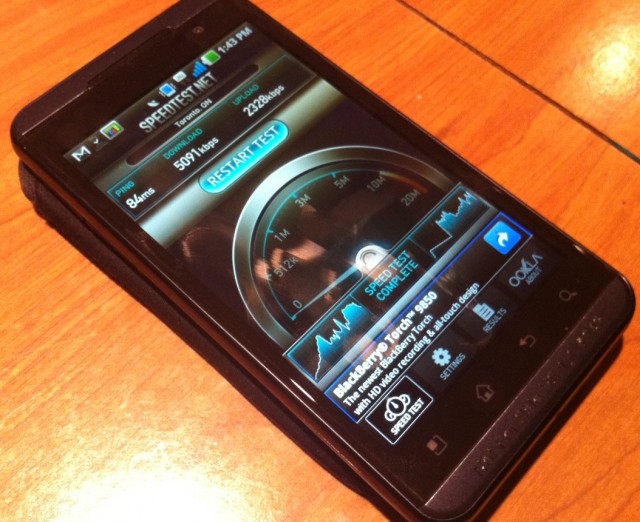
Connectivity and Network Speed:
Unlike the Infuse 4G, which supports speeds of 21Mbps, the Optimus 3D maxes out at a still-healthy 14.4Mbps download speeds. In day-to-day usage we didn’t notice a difference between the two phones, and the O3D kept pace in page loading times and ping times. Using the Speedtest.net application, we got the fastest speeds Rogers has ever offered up on a mobile phone: 5.1Mbps download, 2.3Mbps upload, with an 84ms ping time. Extraordinary results! The device has a very good mono speaker on the back, which emits clean and clip-free voice and music, though range is limited. The headpiece transmits calls loud and clear, and everyone we spoke to had no issues hearing us, and us them. Rogers has always had excellent voice quality, and the Optimus 3D is no exception. Even better, we had great reception on the O3D in areas when the iPhone 4 couldn’t hold a signal.
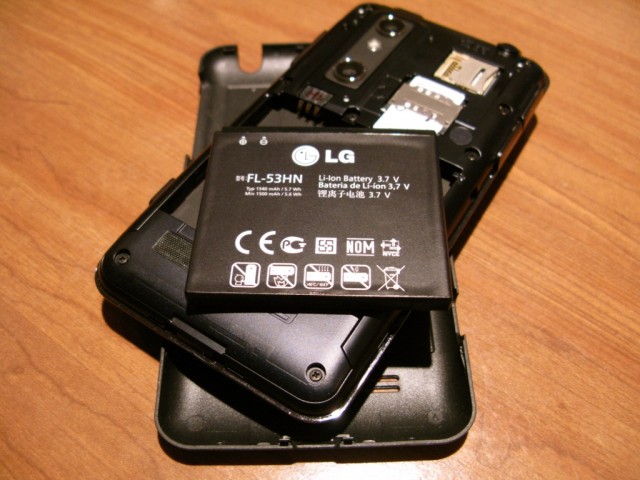
Battery Life:
The question we always have to tackle on a device like this is how much of a toll all that power really is on battery life. The Optimus 3D is decidely middle of the road in the battery department, though with some diligence we managed to last through the day with some juice to spare. The 1540mAh battery is not the largest we’ve seen, and we would have preferred an Infuse-like 1750mAh, but a bigger battery would have meant a fatter device, and LG probably couldn’t abide that. One of the benefits of having such a bright display is that at the lowest setting the screen is still readable, and turning off auto brightness when indoors and keeping it near the bottom gave us a couple extra hours each day. It’s a hassle, and most people will want to leave auto brightness turned on, but if battery life is a huge priority this is one of the best preservation methods. LG does not incorporate any Power Saving features such as automatically turning of WiFi or GPS when the battery gets to a pre-determined value, something we truly value on newer Samsung and HTC devices. Using the camera, especially when shooting 3D, was the biggest battery hog, using just above a percent every minute.
Keep that in mind when taking the phone to your kid’s soccer game, and make sure the device is fully charged beforehand. We are certain, too, that when Gingerbread eventually comes to the Optimus 3D, significant battery improvements will be found, as this was evident on the T-Mobile LG G2x (an Optimus 2X variant) when it was upgraded. Until then, keep a charger close at hand when you’re going on an overnight trip.
Conclusions:
If you can’t already tell, we really, really like the Optimus 3D. Its 3D features may seem gimmicky, and certainly they are, but they’re a bonus feature on an already-loaded product that blows away many of its competitors in terms of performance, screen vibrancy and build quality. It’s also incumbent on us to mention that the O3D is significantly cheaper than the upcoming HTC EVO 3D — $75 less, when purchasing outright, in fact — and that will go a long way to bring buyers to the fold. For those who like the hack their devices, the Optimus 3D has a vibrant modding community and an unlocked bootloader, so rooting/flashing is a no-brainer. As we speak, devs are hard at work bringing the popular CyanogenMOD 7 ROM to the device, 3D features intact. Ultimately, if you can get over the fact that the Optimus 3D runs Froyo, and that it’s bulky, it is assuredly one of the most versatile and affordable Android devices currently on the market. Highly Recommended.
The LG Optimus 3D is availablefor $99.99 on a 3-year term, and $474.99 outright.
Rating: 8.5/10
Pros:
-Beautiful 4.3” display with excellent brightness levels
-Fast processor and advanced GPU make for consistently good performance
-Very cool stereoscopic 3D watching capability
-3D still and video capabilities add value despite gimmickry
-HDMI-out can be used to watch 3D clips on applicable televisions
-Extremely fast network speeds on Rogers
-Good quality 2D stills and video
-Nuanced improvements to Android interface
-Affordable –
Hackable
Cons:
-Bulky, black and heavy
-Watching 3D on the screen can be tiresome, finicky
-Battery life is only OK
-Runs an older version of Android, no set upgrade date
-Front-facing camera only VGA
-Cannot remove pre-installed carrier apps
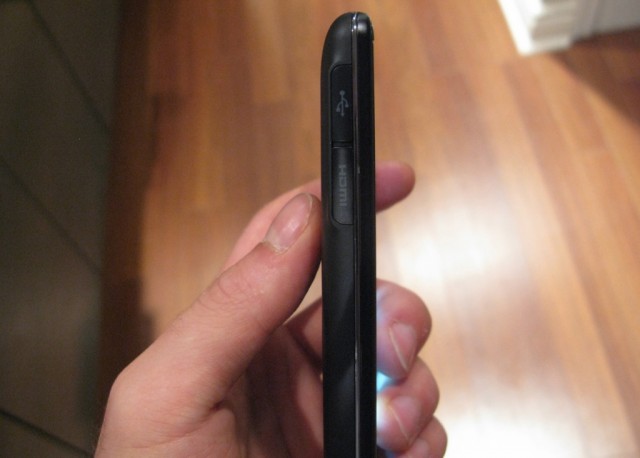
MobileSyrup may earn a commission from purchases made via our links, which helps fund the journalism we provide free on our website. These links do not influence our editorial content. Support us here.

